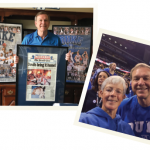Another key collaborative development is that, for the first time, the REF and the ACR conducted their strategic planning in parallel when developing the 2010–2012 strategic plan. “This gave us the opportunity to coordinate our goals and objectives for the next several years,” says Dr. St.Clair.
Incorporating sustainability into its funding programs is one of the REF’s goals, so that the foundation can continue its successful track record of supporting rheumatology research and training, through its core portfolio, and disease-specific research, through programs like Within Our Reach. “We will continue to be a major factor in building careers of young rheumatologists for the foreseeable future,” says Dr. St.Clair. Developing alliances with other organizations is one way of ensuring sustainability. To that end, the REF is collaborating with NIH and the Arthritis Foundation to identify investigators who have submitted high-quality, mentored-training grant applications that didn’t get funded. For investigators who received excellent scores but just missed the funding line at the NIH, the REF has an award to pay their salary for a year. This award allows these talented individuals to go back and reapply to the NIH, says Dr. St.Clair. “In fact, our first six awardees have been successful in obtaining NIH funding, so the program is a great investment.”
Now almost at its $30-million fundraising goal for Within Our Reach, the REF is looking ahead. “We have been very pleased with the success of the Within Our Reach program. We envision this will go forward in some way and RA will be a continued focus of this program,” says Dr. St. Clair. Meanwhile, the REF is planning another disease-targeted research program. Currently, the foundation is gathering feedback from ACR members, REF board members, industry supporters, and lay donors about what the next campaign should focus on, notes Dr. St.Clair.
Sustainability in fundraising sources is another goal from the REF 2010–2012 strategic plan. Within Our Reach’s success expanded the REF’s reach to lay people, patients, and families affected by rheumatic diseases. “We’re trying to expand our visibility to the public,” says Dr. St.Clair. The REF development advisory council will soon include lay donors, and Dr. St.Clair predicts that lay donors will eventually be part of the REF board of directors. “When we go out to the lay public, we get a very warm reception, being rated as a four-star charity [by Charity Navigator, an independent evaluator of charities].” At the REF, ninety cents of every dollar donated goes to educational or research grants and awards.
